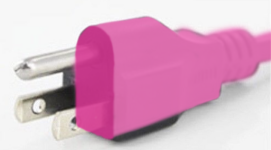This turned out to be more difficult than I had expected. The model's shape is still not exactly what is pictured, but it will work fine for the intended use. How would you go about getting the exact shape? It has the basic 2D shape at the end of the plug. It moves outward. It is rounded. And then it uses a curved taper into a box shape. 0_o...


upload picture
1. Model the plug's large-end shape in 2D ( a box and a half disk up top).
2. Use Multishift to extrude the polygons to about 2/3rds the length of the plug.
3. Select the other end of the plug shape that was made with Multishift and use Multishift to bevel it inward multiple times of the same amount of inset until there is no more room, about 5(?) bevel insets.
4. Select the inner most bevel and then use the Expand Selection to select all but the outermost polygon bevel.
5. Use the Move tool to move the polygons out further in the direction of their normals. Then Contract Selection, Move the polygons about twice as far out. And repeat until all the bevels are pulled outward and form a nice curved taper.
6. Select the points of the horizontal lines of the object at the convex and concave parts of the object and use the Rounder tool to make smooth transitions between the two connecting surfaces.
7. Select the polygons for the back shape of the object and use Multishift to bevel the edge.
8. Clean up the polygons that had points that overshoot each other during the Multishift.
9. The other shapes are more straightforward, so I will not explain those for the metal prongs and cord.


upload picture
1. Model the plug's large-end shape in 2D ( a box and a half disk up top).
2. Use Multishift to extrude the polygons to about 2/3rds the length of the plug.
3. Select the other end of the plug shape that was made with Multishift and use Multishift to bevel it inward multiple times of the same amount of inset until there is no more room, about 5(?) bevel insets.
4. Select the inner most bevel and then use the Expand Selection to select all but the outermost polygon bevel.
5. Use the Move tool to move the polygons out further in the direction of their normals. Then Contract Selection, Move the polygons about twice as far out. And repeat until all the bevels are pulled outward and form a nice curved taper.
6. Select the points of the horizontal lines of the object at the convex and concave parts of the object and use the Rounder tool to make smooth transitions between the two connecting surfaces.
7. Select the polygons for the back shape of the object and use Multishift to bevel the edge.
8. Clean up the polygons that had points that overshoot each other during the Multishift.
9. The other shapes are more straightforward, so I will not explain those for the metal prongs and cord.
Last edited:







